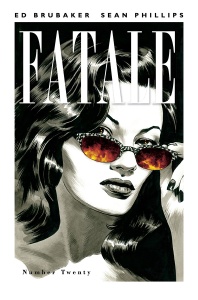
This post contains one NSFW image (due to nudity)
Two and a half years ago Ed Brubaker and Sean Phillips unveiled their latest creator-owned work, Fatale. Similar to their previous collaborations, this one was a riff on the noir genre, only this time with a liberal dose of horror added to the mix. The result was the story of Josephine, a woman blessed/cursed with eternal youth and the charm of being irresistible to men. Given such powers by an ancient Lovecraftian demon worshipping cult, Jo spends much of her energies, eluding their grasp. For the first two arcs, Jo followed the standard template of the femme fatale, seducing and manipulating men to do her dirty work. She did not seem purely maleficent, yet, still there remained a detachment about her. True part of this came from self-awareness, such as in the second arc where Jo has herself isolated from the general hustle and bustle of 1970s Los Angeles. The reader surmises that these measures are in place as much to protect others as to protect herself.

The second arc is also where Brubaker begins to broaden his scope beyond the original noir period of post-World War II. Set within a Los Angeles which alternates between grimy darkness and blinding sun, Brubaker tunneled into the seedy underbelly of the period. The perky idealism of the 60s has been washed away by waves of drug addiction, carnal indulgences and snuff films. This is a vision of America where the greatest cultural legacy of 1969 is not Woodstock but the Manson murders. Indeed, the eons old cult which hunts Jo operates throughout the city in a manner reminiscent of Manson’s Family.
Of course, the 70s saw a revival of interest by Hollywood in the film noir genre, producing such classic “modern” noirs as Chinatown and The Long Goodbye. Each film in their own way dug into the recent past, trying to determine what meaning it had for the present. Elliot Gould’s Philip Marlowe in particular is a man out of time, the last honorable person left standing in a city full of thieves. Brubaker’s portrayal of Los Angeles is equally unsettling. Even when a potential innocent crosses the page, the reader knows she cannot last. After all, we know how these stories typically end.
Fatale was originally solicited as a 12 issue limited series. However, as Brubaker delved further into his fictional world, his ideas for it increased. From a sales standpoint, the series was a runaway success since its debut. Thus, Brubaker announced Fatale would forthwith be an ongoing. He had the same ending in mind, he had simply concluded it would take a little longer to get there. (Twice as long, in fact, as the series wrapped up at week with #24).
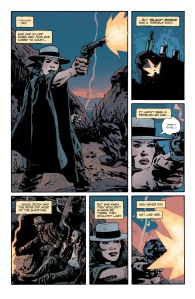
The first indication of what else Brubaker had planned was the set of four stand-alone issues which appeared after the conclusion of the second arc. Two of these focused on Jo at specific points in her life. The other two, however, cast Brubaker’s net even wider, telling tales of Femme Fatales of the past who shared Jo’s burden. The first of these centered on Mathilda in 13th Century France. The second was set in the American West of the 1880s, and followed the path of outlaw “Black” Bonnie Smith. Here again, Brubaker is playing with genres, mixing motifs so that they become fresh once more. This single issue appearance of Bonnie was the best issue to date, partially because a Fatale finally comes across a man with his own magic which shields him from hers. This allows for a different type of dynamic to emerge, as the characters search out some chance for survival, or, even rarer, understanding.
Brubaker continued to discover ways to reinvigorate old plots, when he began his third multi-part arc, Pray for Rain. The setting is now 1990s Seattle. The members of struggling local band, Amsterdam, are sharing a house together. One of their number has turned to robbing banks in order to fund that one music video which could change everything. Then while racing back from his heist, Lance’s car careens into a bloody woman, clothed only in a sheet, darting out of the woods,. Instead of taking her to a hospital, Lance takes the woman back to the house, where there also lives a doctor.
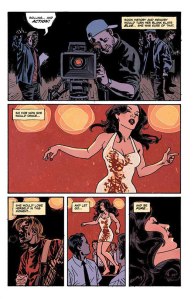
The reader immediately recognizes that the woman is Jo, even she does not. Suffering from amnesia, Jo has forgotten who she is, and along with it, what she is capable of doing. In many ways, this is my favorite arc of the series, watching Jo savor the joys of music, sex and other sensual delights without any of the guilt. States of innocence can only be prolonged for so long, though, and when reality starts crashing down around her, as the bodies begin piling up, the final chapter is truly tragic. More than any other arc, including the last, this is the one where I most hoped against hope that at least some of the blameless bystanders might be spared.
The one through line linking these various tales together has been the present day story of Nicholas Lash. Readers met him in the first arc, as he tried to identify this mysterious woman somehow connected to his uncle, author Dominic Raines and Raines’ unpublished manuscript. Following, Pray for Rain, Brubaker focused his final arc on Nicholas. Jo has grown weary of all the pain she has experienced, as well as caused others to suffer over the decades. She wishes to put a stop to it, end her curse one way or another. And for this purpose, she recruits Nicholas.
In #23, Jo leads Nicholas through sex into a mystical experience. She bares her soul to him. At the heart of it, Nicholas discovers her true tragedy. Jo was literally made resistible to all men, regardless of age. As long as they are mature enough to feel desire, they will want her. Also regardless of blood ties. Thus, out of all the haunting images Brubaker and Phillips have produced, one on the strongest is Jo and Dominic’s thirteen year old son menacingly crawling into his mother’s bed. A week later, he hangs himself in an asylum. “If he can’t have her, he doesn’t want anything . . .”
This is the seeming paradox which makes Jo who she is. We do not love the perfect, but the broken. We might lust after an ideal, but it is not what gains our love, since it would have no need for it. Love is found “in our broken places.” That is where we bond, where we are needed to wipe away tears with comfort. Otherwise, it is simply sharing the fun times, and anyone could do that, right? And so, there is Jo, with a gaping wound so large it can never be filled, her heart ever breaking over and over again. In other words, endlessly desirable to any poor sap who chances upon her.
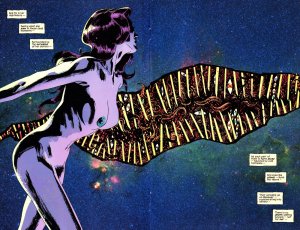
As I said, though, Jo has had enough. In #24, her final plan unfolds. She hopes that they might survive it, but views that concern as secondary. Most important is to make amends by ending the cycle. The issue opens with a beautiful series of stained glass style images retelling an ancient legend of maidens and knights, dragons and sacrifice. The king who oversees ritual slaughter, claims that he is merely preserving the dark truths of violence; blood, not money, is what makes the world go round. The knight does not dispute this, but instead offers a counter argument: “they are not the only truths.” This isn’t to say that Jo’s motives are 100% pure, but rather a mix. In his concluding chapter, Brubaker never denies the reality of brutality which has run through this series since the beginning. At the same time, however, he offers another path. Perhaps there is room left in this corrupt world for some sense of nobility, even self-sacrifice. And within that gesture lies Jo’s hope for redemption.
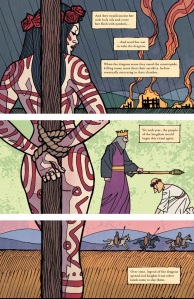
I would be remiss if I did not take a moment to mention Sean Phillips’ brilliant contributions to this series. Issue after issue he produced some of the best art on the stands, including some of the most striking covers. His pages are full of atmosphere, be it that of noir, horror, or some combination of the two. Add the stellar coloring work of first Dave Stewart, then Elizabeth Breitweiser and you have some fantastic images, which will long stay with me.
All in all, it has been a thrilling ride, and I look forward to seeing what this creative team conjures up from their next collaboration, The Fade Out.
Cheers

Folks, if you haven’t read this, do yourself a favor and pick up the trades. It is amazing.